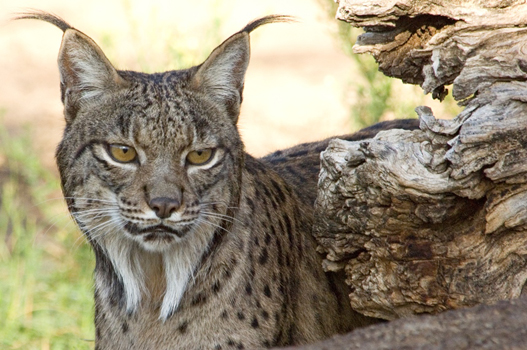Genomic studies of endangered species provide insights into their evolution and demographic history, reveal patterns of genomic erosion that might limit their viability, and offer tools for their effective conservation. The Iberian lynx (Lynx pardinus) is the most endangered felid and a unique example of a species on the brink of extinction. The first annotated draft of the Iberian lynx genome has been generated and genome-based analyses of lynx demography, evolution, and population genetics have been carried out. A series of severe population bottlenecks in the history of the Iberian lynx were identified that predate its known demographic decline during the 20th century and have greatly impacted its genome evolution. Drastically reduced rates of weak-to-strong substitutions associated with GC-biased gene conversion and increased rates of fixation of transposable elements are observed. Multiple signatures of genetic erosion in the two remnant Iberian lynx populations were also found, including a high frequency of potentially deleterious variants and substitutions, as well as the lowest genome-wide genetic diversity reported so far in any species. The genomic features observed in the Iberian lynx genome may hamper short- and long-term viability through reduced fitness and adaptive potential. The knowledge and resources developed in this study will boost the research on felid evolution and conservation genomics and will benefit the ongoing conservation and management of this emblematic species. informacion[at]ebd.csic.es: Abascal et al (2016) Extreme genomic erosion after recurrent demographic bottlenecks in the highly endangered Iberian lynx. Genome Biology. Doi 0.1186/s13059-016-1090-1. Visit the project's website.
http://genomebiology.biomedcentral.com/articles/10.1186/s13059-016-1090-1  Latest News
Latest News
 Las altas temperaturas están provocando que las lagunas y las marismas de Doñana pierdan agua rápidamente
Las altas temperaturas están provocando que las lagunas y las marismas de Doñana pierdan agua rápidamente
La superficie inundada en la marisma es de un 78% pero la profundidad es escasa. Por otra parte, sólo el 1,9% de las lagunas temporales están inundadas. Las precipitaciones crean una oportunidad...
 Traffic noise causes lifelong harm to baby birds
Traffic noise causes lifelong harm to baby birds
A study with CSIC participation reveals for the first time that car noise harms individuals throughout their lifetime even years after exposure
 Illegal wildlife trade, a serious problem for biodiversity and human health
Illegal wildlife trade, a serious problem for biodiversity and human health
A research team led by the Doñana BIological Station and the University Pablo de Olavide have detected wild-caught pets in 95% of the localities in the Neotropic and warns of the risk of zoonotic...
 Urbanization and loss of woody vegetation are changing key traits of arthropod communities
Urbanization and loss of woody vegetation are changing key traits of arthropod communities
Urbanization is favouring smaller beetle species and larger spider species with greater dispersal capacity.
The loss of woody areas is linked to a decline in the duration of the activity...
The loss of woody areas is linked to a decline in the duration of the activity...
 Blood lead levels in an endangered vulture species decreased following restrictions on hunting practices
Blood lead levels in an endangered vulture species decreased following restrictions on hunting practices
Canarian Egyptian vulture was on the verge of extinction at the end of the 20th century. At that time, studies revealed that lead poisoning was a serious problem for the population’s survival. The...
— 5 Items per Page
 Asset Publisher
Asset Publisher
Back






